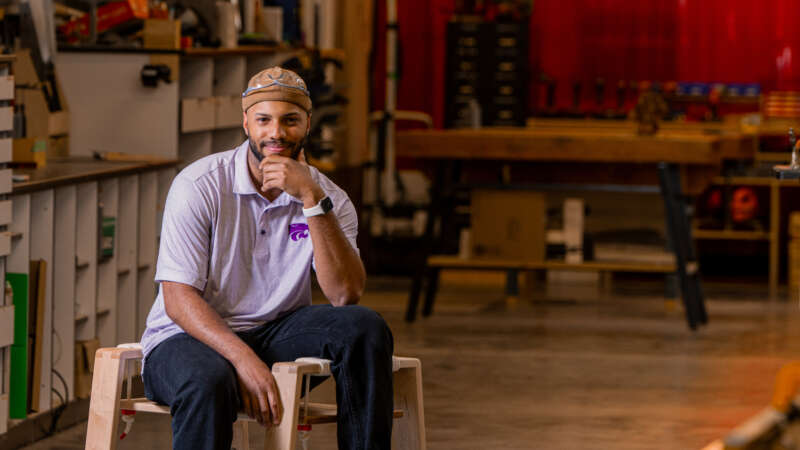The Meadow at K-State’s Beach Museum combines art and science in a natural setting
A piece of prairie exists on campus. The Meadow is a natural laboratory of native grasses, wildflowers, insects, birds and animals growing in the wedge of ground bordered by Beach Museum, Danforth Chapel and McCain Auditorium. The multi-sensory Meadow offers the K-State community cheerful colors, gentle movement, sounds and scents, and discovery in all weather conditions and seasons.
How the Meadow began
What began as a conversation during a gallery opening between the former director of the Beach Museum, Linda Duke, and then associate professor of landscape architecture, Katie Kingery-Page, now associate dean for the College of Architecture, Planning and Design, has become a resource-rich laboratory for aspiring artists, scientists and Wildcats who wish to satisfy their senses with growing wonder.
“Many people appreciate the beauty of the prairie landscape. The art museum has an opportunity to connect that aesthetic experience with the one offered by works of art,” Duke said. “A number of artists in our collection celebrate the prairie landscape.”
Making the Meadow experience possible
It is not uncommon to see a fox step into the Meadow’s prairie grasses at dusk, or hear a lone guitarist strumming chords, or people discovering a new-to-them insect or native wildflower. When the Pride of Wildcat Land practices nearby, visitors to the Meadow experience both the marching band’s music and the Meadow’s music woven with the wind.
Intended to be both accessible art-in-transformation and a sustainably managed landscape, the Meadow has benefited from generous K-State donors and engaged colleagues. “Though campus’ Division of Facilities does not maintain the Meadow, we could not have done it without them, and we are lucky to have them as partners,” said Kingery-Page. “Volunteers, including the Boy Scouts, helped to plant and protect the native plants selected. Volunteers still pull weeds and help maintain the Meadow. The Hummel siblings, Steve, Sara, Kay, Ruth and Rachel, provided for our initial installation costs, in honor of their parents, Sally and Bill Hummel.”
Fred and Judith Henley established the Henley Meadow Excellence Fund as a maintenance fund for the Meadow’s upkeep. Fred is a 1960 landscape architect graduate who worked for the Forest Service in Washington. He and his wife heard about the idea and wanted to help the “minipark” grow.
A living learning landscape
On a recent visit to the Meadow, a group of young learners planted their own prairie wildflowers, made rubbings from the leaves they found, drew what they saw in chalk along the pathways, and practiced new words they learned describing what they saw and touched. Around the corner and through the tiled Bird Arch, a group of senior adults began their tour of the Meadow and other flora on K-State’s Manhattan campus.
“The Meadow is a great learning facility. It’s sort of magic,” said Kathrine Schlageck, associate curator of education at the Beach Museum of Art. “Our collection connection is so strong to the prairie and the Meadow is a little piece of it. It’s not just people who sign up for art classes, tons of art students come to draw in nature when they can’t get out to Konza Prairie. And you’ll see people eating lunch, reading or writing on the natural benches in the Meadow. It offers all of these academic and imaginative opportunities and a little bit of respite. There are so many ways departments use the Meadow.”
The Meadow: discovering community
It’s been said that a museum is a place of informal lifelong learning and exploration. With the added living Meadow exhibit, it becomes more meaningful.
Karen Hummel and the Hummel family are original donors to the Meadow, and she continues to volunteer. She believes that K-State is much richer culturally because of the Beach Museum and references a discovery process that museum educators use to connect experiences people have with art, science and the natural world, Visual Thinking Strategies. “Kathrine’s (Schlageck) work with Visual Thinking Strategies (VTS) has opened a new way of experiencing art. First the (Touch the Prairie) touchscreen in the museum was a link between nature, art and artists,” said Hummel. “Now, you can do a VTS in front of a piece of art and then in the context of the real Meadow.”
You can help the Meadow grow. The Beach Museum’s exhibits and activities, including the outdoor exhibits, are fully funded through philanthropy. To support the Meadow and Beach Museum, give online at www.givecampus.com/campaigns/17132/donations/new or contact Heather Strafuss at heathers@ksufoundation.org or 785-775-2146.
*This article was first published in the winter 2022 Good for K-State magazine.





